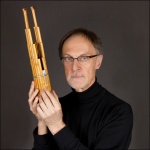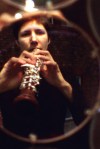Jinny Shaw, oboist with Okeanos Ensemble, the instrumental ensemble for Tokaido Road, reviews Untitled – Max de Wardener’s work for sho, organ & percussion, written for Okeanos’ Robin Thompson.
Composer Max de Wardener is well-known for his versatility; composing for albums, TV and film as well as contemporary classical music. His collaborations include a BFI commission with Ed Finnis for a score to Sergei Eisenstein’s silent film The General Line (1929) responding to a series of composing instructions left by the director.
His latest work, premiered at the South Bank Centre on 22nd March, broadcast live on BBC Radio 3’s ‘Hear & Now’ programme, featured a pre-recorded soundtrack of the Royal Festival Hall organ, incorporated in a live score for percussion and sho.
His neighbour, artist Rebecca Salter, has lived and studied in Japan, and leaving in 1985, was given a sho and koto by her Sponsor, Zen monk Otsuka san. With Rebecca’s assistance, Otsuka Einosuke has since donated his collection of fine Japanese instruments and music to the British Museum.
In February Max and Rebecca met with the sho player and Okinawan music specialist, Robin Thompson. Rebecca adds:
‘Max already knew the sho (there was a concert at King’s Place I think) so seeing the instrument I own sparked his interest and through Richard Blake (a flautist and shakuhachi player) we went to see Robin. At that point he suddenly got the commission from the BBC so decided to try to use organ and sho and ask Robin to play.’
Both composer and artist hold the music of Toru Takemitsu in high esteem and sense the parallel narrative of the ancient and classical harmony in Japanese Gagaku or Court music to a contemporary sound world. Robin Thompson initially evaluated the sho in Rebecca’s possession, leading to, in Max’s words, a ‘brilliant Antiques Roadshow moment’ for the apparent age and rarity of the instrument. It was subsequently returned to Japan, but in fact, turned out to be far less old and valuable when considered by specialists in Tokyo.The classical harmonies of the sho sound surprisingly ‘modern’, and in Max’s composition its clustered whole tones are replicated in the organ’s pre-recorded score. The lines between the two sustaining instruments are initially blurred and fused, the listener guessing as to which sound is live and which recorded. Their texture of pipes and reeds, underpinned by percussion, gradually becomes less diffuse as the instruments’ harmonic identities emerge.
This beautiful work can be seen to embrace the Japanese spatial concept of ‘Ma’ – suggesting the designation of ‘interval’ as a sense of place; in the dual intensity of listening and being, but not necessarily confined to any one experience. Perhaps it is best suggested as lines of force or sound flowing around the listener, as if they are set within the landscape of a Zen rock garden; gently aware in the definitive space, yet simultaneously receiving in imagination a unique horizon. Certainly the importance of ‘interval’ has immense significance in the music.
The harmony of an ancient musical instrument and its discovery has clearly formed a bond between composer, musician and artist, and it is anticipated that their collaboration will continue.
To view Japanese instruments and music generously donated to the British Museum in 1990 by Otsuka Einosuke(大塚榮之助)click here.
Jinny Shaw



